IND 0.3% vs LIB
Incumbent MP
Alex Greenwich, since 2012.
Geography
Central Sydney. The seat of Sydney mainly covers parts of the City of Sydney, as well as parts of the neighbouring Woollahra local government area. It covers the Sydney CBD and the suburbs of Pyrmont, Darlinghurst, Potts Point, Woolloomooloo, Paddington, Woollahra and parts of Ultimo and Surry Hills.
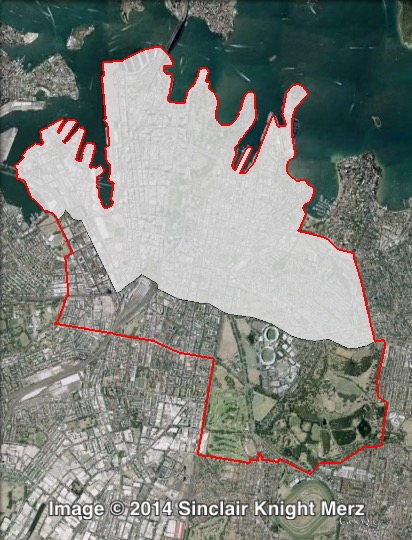
Redistribution
Sydney contracted slightly, losing about half of Surry Hills and the entirety of Chippendale to Newtown, and losing part of Ultimo to Balmain. These changes cut the 2011 margin for independent Clover Moore from 3.1% to 0.3%.
History
The current electoral district of Sydney was only created in 2007, replacing the abolished seat of Bligh.
The original Legislative Assembly had four members elected representing the City of Sydney. In 1859 the seat was split into the two districts of East Sydney and West Sydney. Each district elected four members, and were the most prestigious districts in the colony. Leading political figures would contest these seats, and if they failed to win them, they would then move on to another district, as elections were not all held on the same day.
The 1894 election was the first where all MLAs were elected in single-member districts. The former multi-member districts of South Sydney, East Sydney and West Sydney were broken up into ten districts, all of which had “Sydney” in their name, along with the name of a significant figure in early NSW (Bligh, Phillip, Cook, Gipps, Lang, Flinders, Fitzroy, Denison).
From 1904, the word “Sydney” was dropped, but there continued to be numerous seats in the area now covered by Sydney. The 1904 seats included Pyrmont, Darling Harbour, Surry Hills, Belmore, Darlinghurst, Paddington and King (which covered the CBD itself).
Throughout this period, most of these seats reliably elected Labor candidates. In 1920, the multi-member district of Sydney was created, covering a similar area as the current seat, stretching from Pyrmont/Ultimo to Paddington. The seat elected a majority of Labor MPs for all three elections, but it was abolished in 1927, being replaced by a number of inner-city seats.
By the 1970s, the area only included three seats. The seat of King covered the CBD and stretched west to cover Glebe and Newtown. The seat of Phillip stretched from Surry Hills to Rosebery. The seat of Bligh covered Paddington and Kings Cross.
The 1973 election reduced the number of seats to two. King was abolished, and Phillip moved up to cover Redfern, Glebe, Ultimo and the city centre.
For the 1981, election, Phillip was renamed Elizabeth, and Bligh shifted closer to the city centre. The new boundaries saw the ALP’s Fred Miller win Bligh. He only held it for one term, losing in 1984 to the Liberal Party’s Michael Yabsley.
In 1988, Yabsley was challenged in Bligh by City of Sydney councillor Clover Moore. She had been elected to South Sydney Council in 1980. The council was merged with the City of Sydney in 1981, and she was elected to the new council. Moore was the favourite to win the next Lord Mayoral election when the ALP state government sacked the City of Sydney council in 1987. She then decided to run for the seat of Bligh as an independent, and defeated the sitting member Yabsley.
Not long after the 1988 election, Liberal Member for Vaucluse Ray Aston died, and Yabsley won his seat at the following by-election. He immediately became a minister in the Coalition government. He moved to the backbench in 1992 and resigned in 1994.
Meanwhile, in 1988 the seat covering the CBD and western parts of the City of Sydney was again renamed as McKell. This seat, whatever the name, had been held by the ALP continuously for decades. The seat of Phillip had been won in 1954 by Lord Mayor of Sydney Pat Hills. He became a minister in 1959, and Deputy Premier in 1964. He served as Leader of the Opposition from 1968 until 1973, when he was succeeded by Neville Wran. When Phillip was renamed Elizabeth in 1981 he won the new seat, and retired in 1988.
The again-renamed seat of McKell was won by Sandra Nori, also of the ALP. In 1991, McKell was merged with Balmain to form the new seat of Port Jackson, which stretched from Leichhardt and Balmain to Potts Point and Woolloomooloo. Nori held the seat from 1991 until her retirement in 2007. She served as a minister from 1999 to 2007.
Clover Moore continued to win Bligh throughout the 1990s. In the 1991 parliament she was a number of independent MPs to support the Coalition government in minority. She won re-election in 1991, 1995, 1999 and 2003.
In 2004, the ALP state government merged the City of Sydney and the City of South Sydney together just before the local government elections, much as they had done 23 years earlier. The ALP expected that strong Labor-voting areas in South Sydney would allow Labor to gain control of Sydney Town Hall, and ran former federal minister Michael Lee. Clover Moore ran for Lord Mayor and won a solid victory, with a number of her supporters elected to the City of Sydney council. She won re-election in 2008.
The 2007 redistribution redrew the central Sydney electorates substantially. Port Jackson was split between the seat of Balmain, which covered everything west of Glebe, and the seat of Sydney. Sydney covers the city centre and much of Moore’s former seat of Bligh. Cr Moore moved to the new seat, and won re-election for a sixth term in the Legislative Assembly with relative ease.
At the 2011 election, the Liberal Party gained a substantial swing, increasing their primary vote by 14%. Clover Moore, Labor and the Greens also suffered swings. Labor fell from third place to fourth place on primary votes. Labor had come second after preferences in 2007, but the Liberal Party replaced them in that position in 2011. Clover Moore’s margin fell from 16.6% against Labor in 2007 to 3.1% against the Liberal Party in 2011.
The new Coalition government moved to prohibit the arrangement whereby Clover Moore served as both Lord Mayor and as Member for Sydney. Legislation was passed in 2012 prohibiting sitting MPs from running for council elections, which would allow councillors to shift to Parliament, but would not allow councillors who are MPs to run for re-election. Moore resigned from Sydney in late 2012 to nominate for a third term as Lord Mayor.
The ensuing 2012 by-election was won by independent candidate Alex Greenwich, who was closely aligned with Moore.
Candidates
- Edwina Lloyd (Labor)
- Victor Taffa (Independent)
- Alex Greenwich (Independent)
- David Pelzman (No Land Tax)
- Patrice Pandeleos (Liberal)
- Joanna Rzetelski (Independent)
- Elaine Addae (Christian Democratic Party)
- Chris Brentin (Greens)
Assessment
Clover Moore came close to losing Sydney in 2011, and would have come even closer on the new boundaries.
At the 2012 by-election, Greenwich significantly improved the independent margin compared to Moore, whether this is due to a decline in Liberal support, a backlash against the government’s legislative action to remove Moore, or increased support for a new candidate.
While Greenwich is the favourite to win Sydney, he will need to demonstrate that his popular support can carry over to the general election.
2011 election result
| Candidate | Party | Votes | % | Swing | Redist |
| Clover Moore | Independent | 16,909 | 36.3 | -3.3 | 35.0 |
| Adrian Bartels | Liberal | 16,855 | 36.2 | +14.6 | 39.0 |
| De Brierley Newton | Greens | 5,961 | 12.8 | -2.8 | 12.3 |
| Sacha Blumen | Labor | 5,247 | 11.3 | -8.7 | 10.3 |
| Andrew Patterson | Independent | 676 | 1.5 | +1.5 | 1.4 |
| Peter Madden | Christian Democrats | 508 | 1.1 | +1.1 | 1.1 |
| Victor Shen | Fishing Party | 464 | 1.0 | +1.0 | 1.0 |
2011 two-candidate-preferred result
| Candidate | Party | Votes | % | Redist |
| Clover Moore | Independent | 20,651 | 53.1 | 50.3 |
| Adrian Bartels | Liberal | 18,220 | 46.9 | 49.7 |
2011 two-party-preferred result
| Candidate | Party | Votes | % | Swing | Redist |
| Adrian Bartels | Liberal | 20,843 | 65.5 | +22.4 | 67.9 |
| Sacha Blumen | Labor | 10,970 | 34.5 | -22.4 | 32.1 |
2012 by-election result
| Candidate | Party | Votes | % | Swing |
| Alex Greenwich | Independent | 17,687 | 47.3 | +11.0 |
| Shayne Mallard | Liberal | 11,543 | 30.9 | -5.3 |
| Chris Harris | Greens | 6,616 | 17.7 | +4.9 |
| Glenn Wall | Independent | 825 | 2.2 | +2.2 |
| Robyn Peebles | Christian Democrats | 724 | 1.9 | +0.8 |
2012 by-election two-candidate-preferred result
| Candidate | Party | Votes | % |
| Alex Greenwich | Independent | 21,283 | 63.7 |
| Shayne Mallard | Liberal | 12,120 | 36.3 |
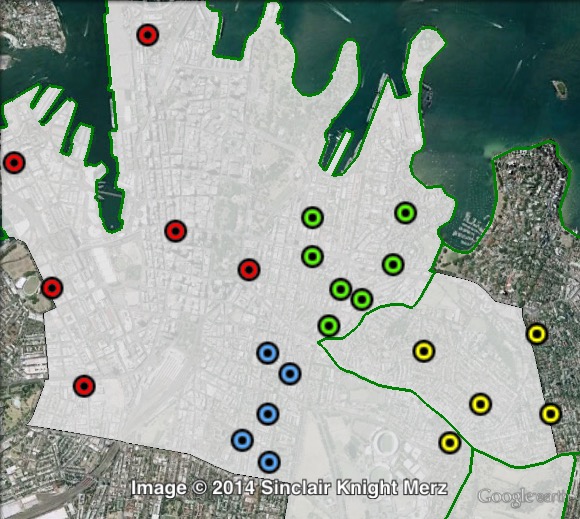
Booth breakdown
On the previous electoral boundaries, Sydney was divided into four areas: Darlinghurst (including Kings Cross and Potts Point), Paddington, Surry Hills and Sydney (covering the CBD, Pyrmont and Ultimo).
For the new electoral boundaries, the remaining booths in Sydney, Pyrmont, Ultimo and Surry Hills have been grouped together as “east”. I have analysed the 2011 election results on the new boundaries, and the 2012 by-election results on the old boundaries.
For the 2011 election, independent Clover Moore’s vote ranged from 34.6% in Paddington to 38% in Darlinghurst. Moore topped the primary vote in the east and Darlinghurst.
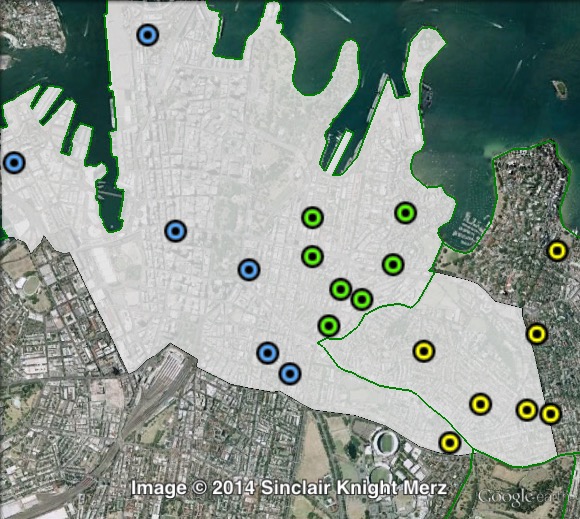
The Liberal Party vote ranged from 34% in Darlinghurst to 45.8% in Paddington. The Liberal Party won in Paddington.
The Greens vote ranged from 10.1% in Paddington to 14.8% in Darlinghurst. The Labor vote ranged from 7.3% in Paddington to 11.3% in the east.
At the 2012 by-election, Alex Greenwich’s vote ranged from 43% in Paddington to 57% in Surry Hills.
The Liberal vote ranged from 20% in Surry Hills to 38.5% in Paddington. The Greens vote ranged from 15.7% to 20% in Surry Hills.
2011 election breakdown
| Voter group | IND % | LIB % | GRN % | ALP % | Total | % of votes |
| East | 37.2 | 36.6 | 10.6 | 11.3 | 10,648 | 28.5 |
| Darlinghurst | 38.0 | 34.0 | 14.8 | 10.1 | 9,116 | 24.4 |
| Paddington | 34.6 | 45.8 | 10.1 | 7.3 | 6,933 | 18.6 |
| Other votes | 30.5 | 41.2 | 13.2 | 11.5 | 10,642 | 28.5 |
2012 by-election breakdown
| Voter group | IND % | LIB % | GRN % | Total | % of votes |
| Sydney | 44.1 | 32.6 | 17.9 | 8,842 | 23.6 |
| Darlinghurst | 52.0 | 27.2 | 17.8 | 8,079 | 21.6 |
| Paddington | 42.7 | 38.5 | 15.7 | 5,801 | 15.5 |
| Surry Hills | 56.9 | 19.9 | 19.8 | 4,762 | 12.7 |
| Other votes | 44.4 | 33.1 | 17.5 | 9,911 | 26.5 |
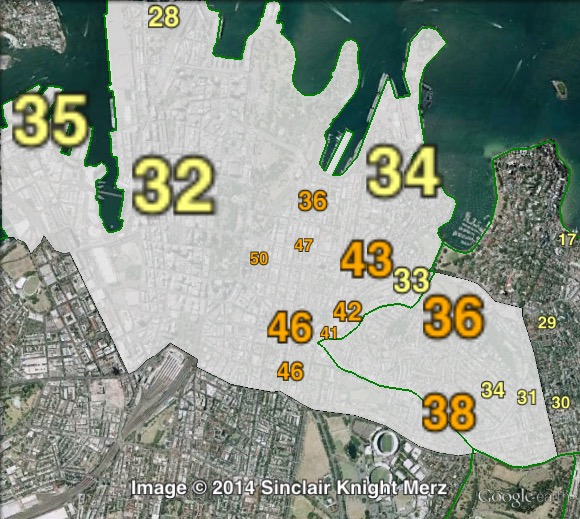
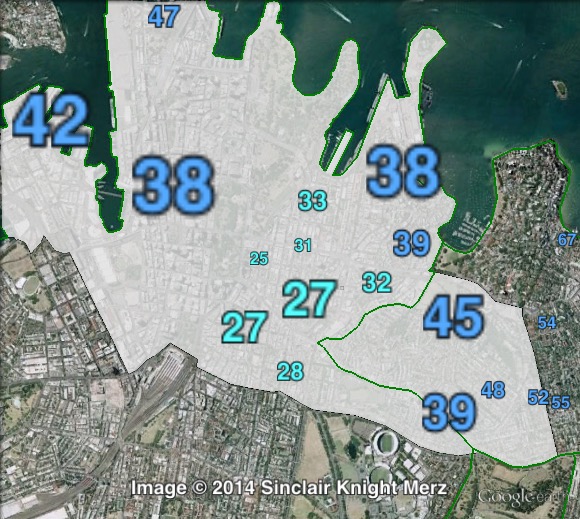
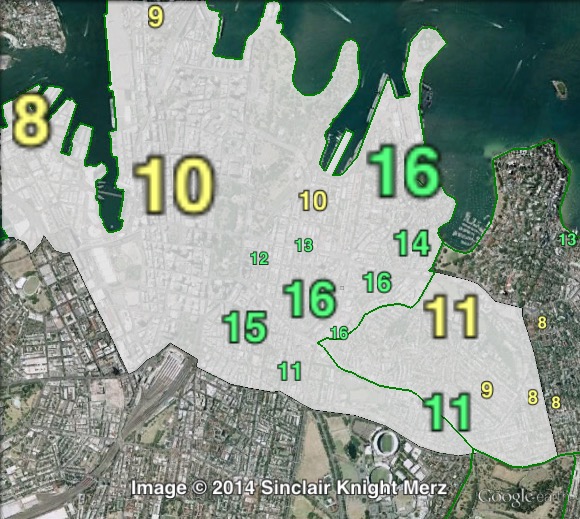
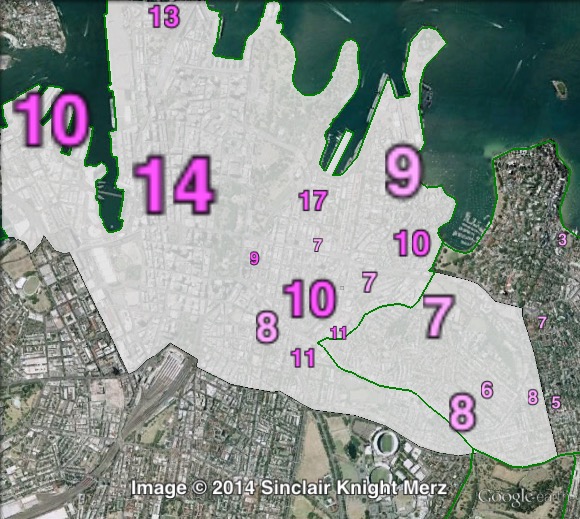
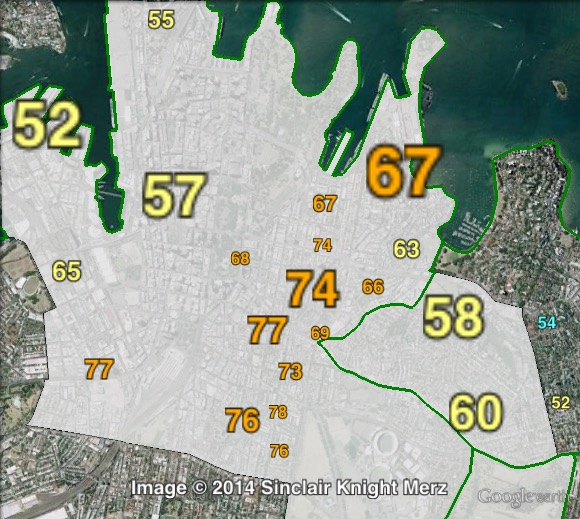
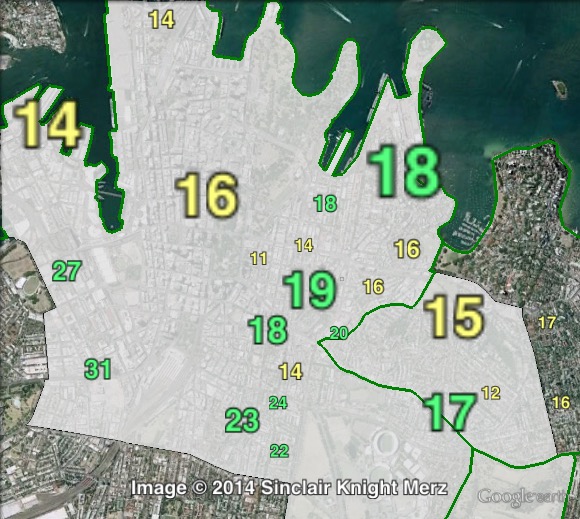


My prediction: Greenwich will win his first general election. As for second place, hard to call – could be Labor, could be the Greens, could be (less likely) the Liberals.
An Ind v Grn margin would be one for the history books. The only similar recent thing is Peter Wellington vs One Nation in Qld in 2001.
Second place in first preferences will probably be the Liberals, since the left wing vote is split between Labor and the Greens. As for 2CP, a 12% swing away from the Liberals is required for Labor or the Greens to come second.
No Labor candidate in the by-election may have also helped Greenwich.
I would think the Liberals will remain in the top two. For Greenwich preference flows from Labor and the Greens will be important – the more they campaign and if there isn’t a strong effort to get voters preferencing, the more this could go Liberal.
Independents elected at by-elections in the city don’t have a very good record in the past. Robyn Read lost North Shore in 1991 after winning it at a by-election when Ted Mack retired. Alex McTaggart lost Pittwater in 2007 after his 2005 by-election win. Greenwich isn’t Moore, and it’s by no means certain on historical trends that his by-election result will be repeated here.
I tend to think Greenwich will hold on, but I certainly won’t be betting on it at the extremely short odds currenlty available.
I recall Kristina Keneally endorsed Greenwich in the by-election too.
I haven’t been following his progress, but you’d think Greenwich would hold given broader political trends. Labor can’t pick this up yet, I don’t think the Greens can, and the Lib vote will drop, so Greenwich makes sense.
Alex Greenwich will easily hold on. I believe Labor will come second although most of Greenwich’s vote comes from traditional Labor and Greens voters, but since the Liberals have decided to preference Greenwich as well as the Greens, i believe that Greenwich voters that consider themselves traditional Inner-city leftist will vote Labor due to the fact that Greenwich is now in bed with the Liberals
As continued developments around the shore-line continue, I expect this seat to get even more marginally between IND and LIB, especially with half of Greenwich’s support base being transferred to the new seat of Newtown.
Patrice Pandeleous also comes in with experience, having sent a fright through the ALP from the last election after their surprising result in the seat of Heffron in 2011.
I’m assuming by “fright”, you mean “sixth-best Labor result in the election”. Not a high bar, admittedly, but the Libs didn’t come close to winning Heffron so I hardly think that’s an issue.
In 2011 Pandeleos lived in Pyrmont and didn’t do a spot of campaigning in Heffron. This seat at least will be more of a fit for her, but I really can’t see how the Libs can win with a declining vote. There’s an outside chance they may not even make the 2PP (it wasn’t that long ago Labor came second in Sydney).